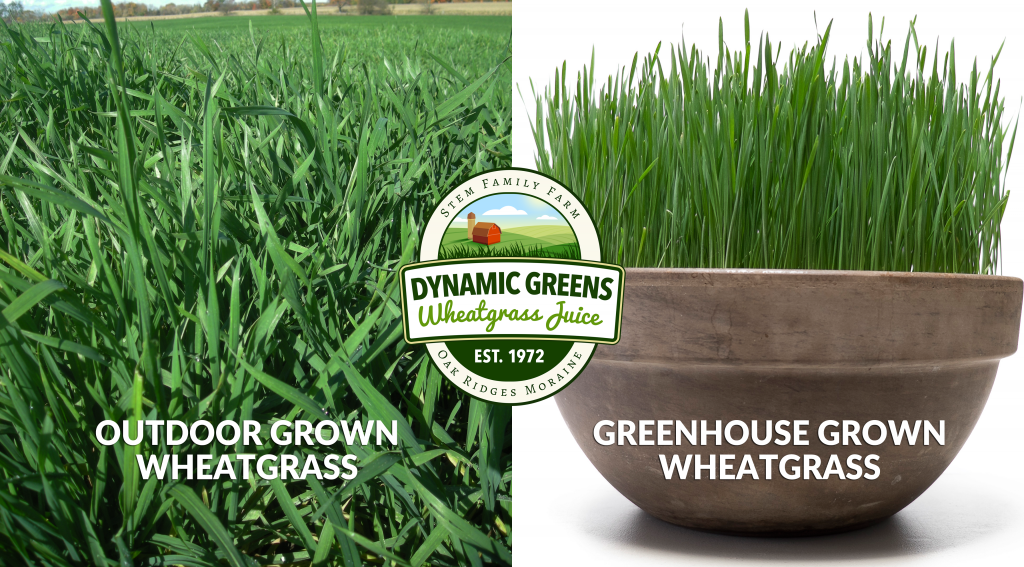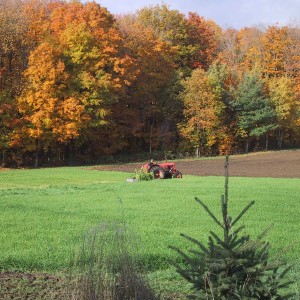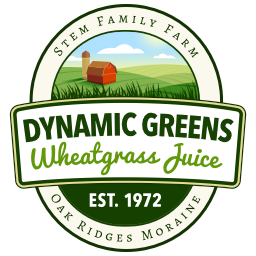Field Grown Wheatgrass vs Greenhouse Grown Wheatgrass

Customer Question
I am super curious as to why your juice tastes and smells so different to home or greenhouse grown wheatgrass juice. I’ve grown my own juice for a while and just purchased my first batch of your juice and was shocked at how different it tastes. It’s a milder and more “salad like” taste. A good thing, but makes me wonder what the difference is. Do you know for certain that the juice you produce is more nutrient dense than normal homegrown wheatgrass?
The Answer
The two major tastes of bitterness and sweetness are not present in the natural wheatgrass plant and therefore, are not found in our juice. These tastes are not natural, they are created by growing wheatgrass in an artificial environment. Let’s explore these:
Bitterness
This is caused by mold growing with the plant. Having mold is virtually 100% guaranteed in the greenhouse. It’s presence has nothing to do with whether or not someone is a conscientious grower. Mold spores cover ever square inch of the planet. The question is simply whether or not you create an environment conducive to mold growth. The greenhouse does and it simply isn’t controllable although it can be reduced with good management. Mold is strange stuff. It’s presence can range from virtually non-existent to terribly overgrown. Types can be blue-green, white whispy, brown or black. They can be highly poisonous or non-pathenogenic. What molds do is create a bitter taste and when present, they also releases poisons called mycotoxins. Mycotoxis are unusual in that an identical wheatgrass drink can have a serious negative affect in some individuals and for others, the exact same juice won’t affect them at all.
Mold presence is easy to spot. It creates bitterness in taste, holding your nose due to a protesting orafactory sense (not specifically due to bad smell), dizziness after ingestion, instant splitting headache, nausea and with many over 4 fl oz of consumption may cause them to vomit. These things have frequently been incorrectly characterized as “detox” when in fact they are low grade food poisoning. Bitterness is not present in our juice because there are no detectable molds and of course, also no negative side-effects.
Sweetness
Sugar levels in juice are rated in Brix. Outdoor grown wheatgrass juice tests at 0 Brix (no sugar). Tray grown wheatgrass juice tests anywhere between 5 Brix and 20 Brix. 1 Brix equals approximately 1.5% sugar and wheatgrass juice grown in the greenhouse will normally have about 15% sugar. In the field, these simple sugars convert to complex carbohydrates and our juice is test as sugar free.
Exact Nutritional Differences
No one knows the exact differences between any products. What we have are certain markers (say Vitamin C) but it is a gross exageration for anyone to declare full knowledge based upon a few markers. What I have done is attach a picture of wheatgrass grown outdoors vs grown indoors. You will see that the plants look nothing alike. However, the plants in both photos are ours and they were grown with the same seed. The outdoor field grown photograph is from one of our fields, the indoor grown grass for a photo shoot we commissioned.
You just need to know that nutrition in the plant is formed when it responds to its external environment. In nature, when the wind blows, plants strengthen their root system. When it is cold, the roots release potassium into the plant. When precipitation is low, the nutrients become more densely packed. When it rains, the plants absorb water and in the case of wheatgrass, the juice sweetens. The differences are literally infinite!
When we look at the markets, most nutrients run 10% – 20% higher while others can be as high as 50% higher or more. Here is a link to the most complete greenhouse grass testing ever done https://goo.gl/KnLAkv and here is a link to our nutrition facts testing https://goo.gl/hpuFxI. In this case, the potassium level for indoor grasses is 42mg / oz. In our testing, the potassium was 162mg / oz or 285% higher. Iron indoors is 0.17 mg / oz. Iron outdoors is 0.3 mg / oz or 70% higher. Just a couple of examples, you can check out the rest on your own. Remember that testing is just a snapshot of a point in time. There will always be variations and you are simply looking for trends.
Even given this info, you don’t buy our wheatgrass juice because it has better nutritionals. There are tremendous benefits in tray grown wheatgrass too! You buy our juice because it has great quality, the price is awesome and most important, it is mold free which improves its taste and tolerance. Someone can’t benefit from wheatgrass juice if they can’t drink it!
 Our fall harvest was very successful. Just wanted to let everyone know that we have an ample supply of terrific juice. You will be able to get what you want when you want.
Our fall harvest was very successful. Just wanted to let everyone know that we have an ample supply of terrific juice. You will be able to get what you want when you want.